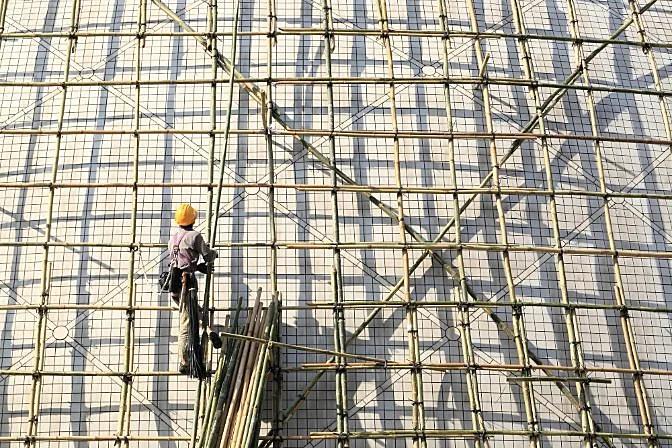Temporary Roof Scaffolding for Your Construction or Renovation Project
Temporary Roof Scaffolding for Your Construction or Renovation Project
Blog Article
The Advantages of Scaffolding for Safety and Efficiency in Building Projects
Scaffolding is an essential part in the realm of construction, dramatically adding to both safety and functional effectiveness. The impact of scaffolding expands beyond standard security steps; its critical application can transform job timelines and outcomes (Scaffolding).
Boosted Worker Safety And Security

Enhanced worker security is an extremely important issue in the building and construction industry, where the dangers linked with falls and mishaps can have alarming consequences. Efficient scaffolding systems play a critical role in reducing these dangers by providing stable platforms for workers at raised elevations. By making certain that scaffolding is correctly set up and kept, construction companies can considerably minimize the chance of drops, which are amongst the leading reasons for workplace injuries and fatalities.
Furthermore, scaffolding improves safety and security via its design features. Guardrails, toe boards, and non-slip surfaces add to a protected workplace, minimizing the danger of mishaps. Furthermore, scaffolding allows workers to access hard-to-reach areas without the need for makeshift services, which can jeopardize security requirements.
Educating employees on the appropriate use scaffolding is just as essential. Making certain that employees are experienced regarding tons capacities, setting up treatments, and security protocols better improves the efficiency of scaffolding in avoiding crashes. Finally, integrating robust scaffolding systems within building and construction jobs not only boosts worker safety yet likewise promotes a society of security that benefits the whole workforce while boosting general productivity.
Improved Accessibility and Flexibility

Moreover, scaffolding allows for the convenient transportation of tools and materials, minimizing downtime connected with moving devices. Employees can successfully access numerous locations of a task, which is specifically essential in intricate builds where upright and straight movement is constant - Scaffolding. This accessibility not only simplifies procedures but also enables teams to respond promptly to transforming project demands
Additionally, scaffolding can be customized to suit certain website conditions, enhancing mobility in limited or uneven areas. This flexibility makes certain that construction activities can proceed smoothly, no matter of the challenges provided by the atmosphere. By promoting enhanced gain access to and flexibility, scaffolding plays a critical role in supporting building staffs and enhancing the total performance of structure tasks.
Increased Job Effectiveness
In construction, job performance is considerably affected by the reliable use of scaffolding systems. By offering a protected and steady system for workers, scaffolding lessens downtime and accelerates the speed of construction tasks. With better access to raised workplace, teams can finish tasks quicker, decreasing the total project timeline.
The modular nature of contemporary scaffolding enables rapid assembly and disassembly, making it possible for swift shifts between various phases of a project. This versatility not just enhances process yet also contributes to much better control amongst various trades, as several groups can function at the same time on various areas of a structure.
In addition, scaffolding guarantees that employees are located correctly to perform their tasks without unnecessary pressure or threat of injury, thereby decreasing the probability of mishaps that can bring about pricey hold-ups. Boosted safety and security measures embedded in scaffolding systems, such as guardrails and toe boards, further support efficient operations by maintaining worker focus on the task at hand as opposed to safety and security concerns.

Adaptability for Numerous Jobs
Scaffolding systems stick out for their flexibility across a wide variety of building projects, qualified of meeting details site needs and tasks. Their modular layout permits fast changes to fit numerous building types, from domestic to business structures, guaranteeing that employees have safe gain access to at various heights and angles.
These systems can be tailored for varied applications, such as façade work, indoor remodellings, or sturdy industrial jobs. As an example, light-weight aluminum scaffolds are suitable for indoor work, while robust steel structures give the essential assistance for large-scale construction. The versatility of scaffolding includes its capability to be configured for both permanent and temporary structures, allowing specialists to effectively prepare and perform their jobs.
In addition, scaffolding can be used in tough environments, including city setups where room is minimal or on uneven surface where traditional accessibility remedies are not practical. This adaptability lessens the requirement for multiple accessibility options, decreasing prices and job timelines. By accommodating a selection of problems and tasks, scaffolding boosts the general efficiency and efficiency of building initiatives, showing to be a vital possession in the structure market.
Conformity With Security Requirements
Exactly how can construction jobs ensure the security of employees while preserving performance? Compliance with security standards is vital in achieving this equilibrium. Governing frameworks, such as OSHA in the USA, provide guidelines that control using scaffolding, making sure that it fulfills rigid safety and security criteria. By sticking to these criteria, building firms scaffolding questions examples can minimize the danger of crashes, which not only safeguards employees but likewise boosts overall job performance.
Correct scaffolding scaffolding planks design and installation play a vital duty in compliance. Scaffolds must be constructed from premium products and created to hold up against the specific loads they will encounter. Regular evaluations and maintenance are vital to make sure that these structures remain safe throughout the project duration. Training employees on secure scaffold usage and the value of conformity with security standards even more reinforces a culture of safety and security on-site.
In addition, documents and record-keeping relevant to security evaluations and worker training are essential. These methods not only show compliance but additionally offer accountability and openness. Eventually, by focusing on adherence to security standards, building and construction jobs can promote a safer workplace, therefore enhancing productivity and performance without compromising employee security.
Conclusion
In conclusion, scaffolding serves as a vital part in building jobs, substantially boosting safety and efficiency. Adherence to security requirements highlights the relevance of scaffolding in achieving successful job results, making it vital in the building sector.
Scaffolding is a crucial part in the world of building and construction, dramatically adding to both safety and security and functional effectiveness. The effect of scaffolding prolongs beyond basic safety actions; its critical execution can change job timelines and results. In conclusion, incorporating durable scaffolding systems within building jobs not only boosts employee security but also advertises a society of safety that benefits the whole labor force while enhancing overall performance.
In final thought, scaffolding serves as an important part in structure projects, significantly boosting safety and security and efficiency. Adherence to safety and security requirements underscores the importance of scaffolding in her explanation attaining successful project end results, making it important in the construction sector.
Report this page